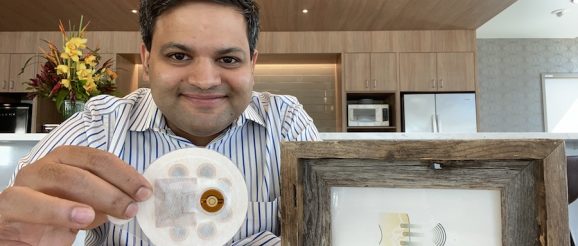Fogarty Innovation Company G-Tech Poised to Revolutionize GI Tracking – Fogarty Innovation

The phrase “listen to your gut” will soon take on a whole new meaning for millions of practitioners and their patients, thanks to G-Tech, the Fogarty Innovation company that is developing a low-cost diagnostic solution for patients with chronic gastrointestinal disorders. It has recently had a number of successes and advances, spurred by the $3.5 million it raised last year.
G-Tech monitoring system readies for market
The company has developed a new generation of its non-invasive wearable monitoring system, which it has recently submitted for 510(k) FDA clearance. The thin, flexible, comfortable patch is worn on the skin to track the electrical signals that naturally occur in the digestive tract — also called the gastrointestinal or GI tract — due to muscle contractions of the stomach and intestines. The new iteration offers a longer lifetime and greater comfort, along with other improvements that contribute to a better overall performance, such as onboard memory, timestamping and more.
Functioning as an “EKG for the gut,” the wireless GI monitoring system measures activity in the stomach, small intestines and colon over multiple days to diagnose underlying causes of GI disorders. That allows physicians to develop targeted therapies with the aim of speeding patient recovery and lowering the cost of health care. Over 500 tests have already been conducted at prominent institutions, including El Camino Hospital, Children’s Hospital of Philadelphia, the Parkinson’s Institute and Clinical Center and different divisions at the Stanford University Medical Center. The technology has also been featured in four peer-reviewed publications and highlighted in numerous conference posters.
An expanding team supports advances
This success wouldn’t have come without a strong and capable team, including Anand Navalgund PhD, director of clinical science, and Lindsay Axelrod, staff research associate, says G-Tech CEO Steve Axelrod, Ph.D. “I’m very proud of our small, but exceedingly nimble group, and the company culture we have created. Everyone has a very strong work ethic and steps in where needed with a willingness to learn new skillsets.”
In particular, he mentions the crucial role Anand and Lindsay played in bringing the 510(k) to reality. “Its completion owes a great deal to their above-and-beyond efforts, and I’m excited to see what’s next as we turn the corner from focusing on developing the technology to taking it to market.”
G-Tech has also added a new, seasoned member, Rob Kirby, who will serve as vice president of strategy and business development. Rob has over 20 years of experience working with medtech startups, with previous leadership roles at TAE Life Sciences and Xoft, and will be instrumental to G-Tech’s next phase.
Looking forward to disrupting the market
As the team anticipates 510(k) FDA approval, Steve reflected on the challenging development process, given that they are doing something entirely new, with no equivalent predicate to compare to. “There is currently no gold standard, so it was entirely on us to show the technological differences between the predicate and our device to ensure the measurement we are making is valid.”
For example, while the predicate only measures the stomach activity for one hour at the doctor’s office, G-Tech’s device measures it continuously in the comfort of a patient’s home for multiple days, which gives a more accurate reading, and also measures the activity in the intestines.
G-Tech’s system also picks up signals externally and non-invasively, compared with pressure sensors that would otherwise be placed in children who need to endure anesthesia to have them inserted internally. Based on studies in collaboration with the Children’s Hospital of Philadelphia and others, G-tech is demonstrating the monitoring system’s ability to pick up the same signals in a far more efficient and comfortable way, which shows a real opportunity to vastly improve patient care.
The company hopes to get clearance in several months to extend its clinical use, launching more studies to see when patients who are recovering from surgery are ready to be fed. “We look forward to finalizing our algorithms to see how we can best use that data for a pivotal study that ideally will show how doctors can reduce the length of stay and complications by optimizing the point at which patients eat.”
In parallel, they’ll continue studies on ambulatory patients, like G-Tech team member Lindsay who has Crohn’s disease, and ultimately expand its use to help treat irritable bowel syndrome (IBS). They’ve received interest from numerous potential user groups, from a radiation oncologist who wants to study how patients with abdominal cancer can better manage radiation to avoid severe gut impact, to practitioners who want to study the effect of spinal cord injury on the gut, to a specialist who wants to determine whether massage therapy helps IBS patients, to pharmaceutical companies.
“We are excited at the many prospects and appreciate our partners who are helping us explore the incredible universe of things that this motility measurement can tackle,” Steve said. “There’s everything from the post-op market, which encompasses 4.5 billion abdominal surgeries a year in the U.S. alone, to the personal cases, like helping Lindsay, who happens to also be my daughter.”
